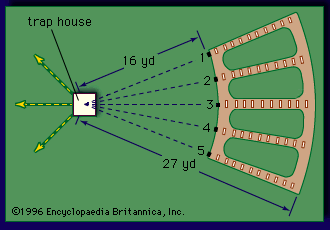2025 program available soon!
Click here to check out the Manitoba Trapshooting Association Webpage
Its a type of clay target shooting. You repeatedly point, fire and break the 4 1/4 inch disc which are hurled through the air at a speed of 42mph.
Trapshooting is slowly growing in popularity due to the fact that people of all ages, incomes and abilities can compete. 10 years old's can shoot alongside 90 year old's! Many 70-year old's have been in the sport 55 years and some began just two years ago. Trapshooter's are a plethora of individuals, businessmen, sports figures, actors, farmers, truck drivers, musicians, students and housewives....ect
The shooter is required to shoot at a target after they call for it. It does not matter if you only a small piece of the target or whether you shatters the entire target. A hit in some way, shape or form is still considered a hit.
Registered trapshooting is competition that is regulated by the Amateur Trapshooting Association. Gun clubs hold shoots in accordance with ATA rules, and they must apply and register for each shoot. All participants of these shoots must be ATA members. The shooters scores are recorded in the ATA office where all records are kept and yearly averages computed. The records are used for handicapping and classifying shooters.
In registered trapshooting, targets must be thrown no less than 48 yards no more than 52 yards and should be between 8 and 12 feet high and 10 yards from the trap. Shooters stand a minimum of 16 yards from the trap houses.
Singles is considered to be the easiest of the three disciplines. In singles, the shooter stands 16 yards away from the center of the "trap house" and shoots at random targets that fly at various angles in front of him/ her. Shooters are grouped into squads, usually made up of up to five people. There are five positions that each shooter shoots from, five shots per position, totaling to twenty five shots or one round. This gives participants a different view of the target flying through the air. Each position is a constant 16 yards from the trap house, each one is spaced equally spaced in a semi circle around the trap house.
Doubles was added to tournament play in 1911. It is a modified version of Singles, but it is more difficult because shooters must break two targets fired at the trap house simultaneously. One clay pigeon flies to the left while the other flies to the right. The target path remains constant, but the challenge is if the shooter can hit both targets before they hit the ground. Each target is scored individually, not as a pair.
Handicap is considered the most prestigious event in trapshooting. As in other sports, handicapping strives to make the competition equal. This is accomplished by having the more skilled competitors stand further away from the trap house. Based on a shooter's past performances, a shooter is assigned a handicap distance which he/she must shoot. A competitor with less skill would shoot no closer than the 18 yard line, while the most skilled shooter is placed at the 27 yard line where it is extremely difficult to win an event.

History Of Trap Shooting
• 1750- Origin of trapshooting in England.
• 1810- First documented history of trapshooting at the Hornsey Wood Pigeonn Club in England.
• 1831 - Inauguration of trapshooting in America. The first official records were kept at the Sportsmen's Club in Cincinnati.
• 1840 - New York Sportsman's Club held its first trapshooting competition.
• 1866 - First glass ball competition.
• 1880- George Ligowsky of Cincinnati created the clay target.
• 1885 - First national trapshooting tournament staged in New Orleans.
• 1890- Interstate Trapshooting Association was formed.
• 1900- First Grand American held at Interstate Park in Queens, New York.
• 1909 - First automatic trap machines were used.
• 1911- Doubles was introduced for the first time.
• 1913- First Women's Trapshooting Club (Dupont Gun Club in Wilmington, DE)
• 1919- Name was changed from Interstate Association to the American Trapshooting Association.
• 1923 - American Trapshooting Association later became Amateur Trapshooting Association.
• 1924- Permanent ATA home built in Vandalia, OH.
• 1969- New addition to the main clubhouse. The Hall of Fame was dedicated.
• 1976 - Youth Trapshooting Program was undertaken in conjunction with the Trapshooting Hall of Fame.
• 1977- All-American team selection became an official function of the ATA.
• 1980- First National Trapshooting Day.
• 1998 - A Day at the Range was introduced, an educational seminar that introduces females to the sport of trap.
• 1999- Grand American World Championships celebrates its 100th anniversary.
• 2006- The Grand American debuts at the World Shooting & Recreational Complex - Sparta, IL
• 2012- The ATA offices relocate to Sparta, IL

